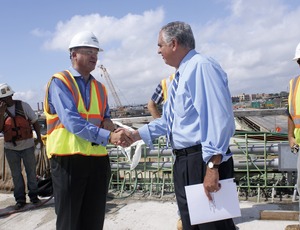
Ray LaHood, who announced Jan. 29 he would be stepping down as head of the Dept. of Transportation, looked back on his four years as DOT Secretary in a telephone interview Feb. 4 with Tom Ichniowski, ENR’s Washington bureau chief.
LaHood also discussed his decision to leave DOT and hinted that President Obama will have “bold things to say" about infrastructure in his second term. An edited version of the interview follows.
What do you see as your major accomplishments in the infrastructure or construction area during your tenure as Secretary?
I really think that one of the real legacies for President Obama when it comes to transportation will be high-speed rail. When you look…over four years, we’ve invested over $12 billion, which is 12 billion times more than has ever been invested in passenger rail. I think that’s a huge investment in just a very short period of time.
And when you look at the plan and you look at the vision for high-speed rail, I think it’s a significant investment in infrastructure and created a lot of jobs in a very short period of time.
I also think that the $48 billion that we received in the economic recovery plan, $28 billion for roads and bridges and $8 billion for high-speed rail, $8 billion for transit and a billion for runways and ramps—that was a huge investment. That put about 65,000 people to work….
And that was done in two years and it was all done by the book and no boondoggles, no earmarks, no sweetheart deals, so I think those two areas really are significant in four years.
Just two other things legislatively—passing a transportation bill, a two-year bill [MAP-21], was a significant achievement for the Congress and whatever part we played in that, was I think important. And then passing an FAA bill which will invest billions of dollars into next-generation technology in every airport in the country is also a big deal.
Now the last two that I mentioned, obviously we’re just beginning with those, but the first two I think are money that’s really out there and the last two are money that will be spent in the future.
Looking ahead to your successor, what sort of challenges in the infrastructure field will he or she face? What would you like your successor to accomplish in the infrastructure area?
What you do in this job is you carry out the President’s agenda. And the President’s agenda will be to push Congress to pass a multi-year transportation bill and to find the resources to pay for all of the things that everybody knows we need to do in America. America is way behind in infrastructure. At one time America was the leader in infrastructure. But we just have not made the investments. So I think whoever follows on will carry out a very strong infrastructure program, led by the President to get Congress to pass a multi-year bill and fund it in a substantial way.
Let me ask a more detailed question along those lines. What do you think your successor, or what would you recommend doing to fix the Highway Trust Fund‘s financial problems—which are of long standing—in the near term and the longer term?
I have discussed this with the President and he has some very strong ideas. So I think eventually the President when he gets around to announcing his infrastructure agenda will have some very important things to say about this. And I’ll leave it to him to say what’s on his mind about it.
So, no details then?
Not really.
So he’s planning to introduce a...
Oh, no, I didn’t say he’s going to introduce [something]...What I think he will do—obviously he’s working on immigration, obviously he’s working on some gun issues and he’s focusing on trying to get his Cabinet in place for the second term, but when he gets around to talking about infrastructure, I think he’ll have some very bold things to say.
One follow-up on rail...what do you think needs to change in the U.S. so that the high-speed rail system for which you helped lay the groundwork, what would it take to get a system in the U.S. that’s comparable to those in China and France and Germany and Japan and Spain? I know you visited at least some of those.
You know, I visited 18 countries in the last four years, all around high-speed rail. And I think the one common thread that runs though the development of passenger rail, high-speed rail is the investment and the commitment from the national government.
We’ve never had it, until four years ago. And the President put $8 billion in the economic recovery plan and that jump-started our opportunity to implement passenger rail—first time ever. That is what has to continue. There has to be a national commitment from the national government—not just lip service but resources and that has to be matched with private dollars. There’s not enough money in Washington to do what we have to do.


Post a comment to this article
Report Abusive Comment